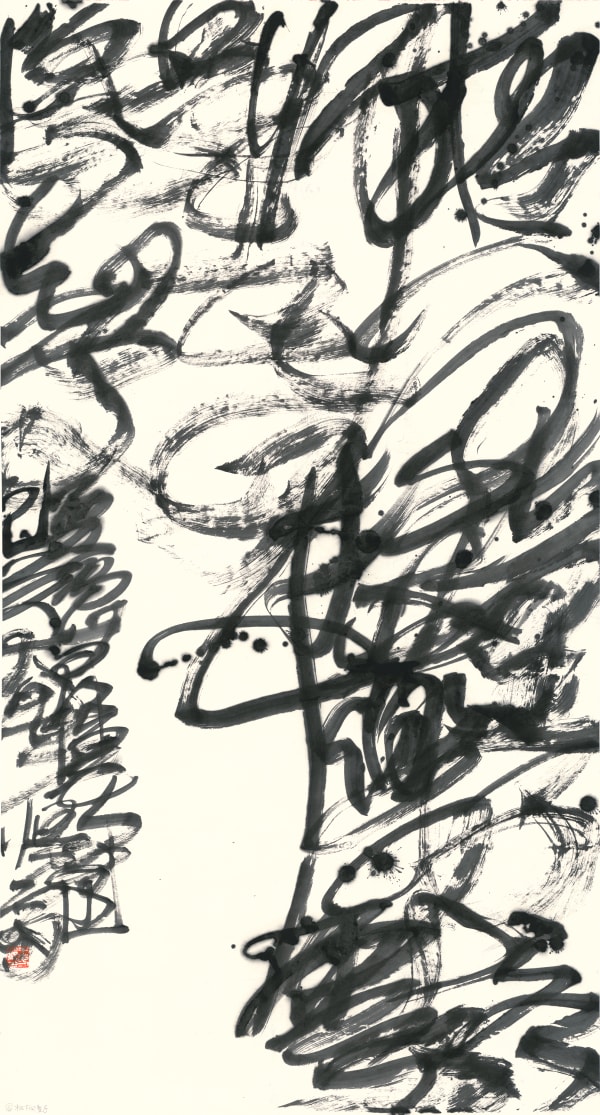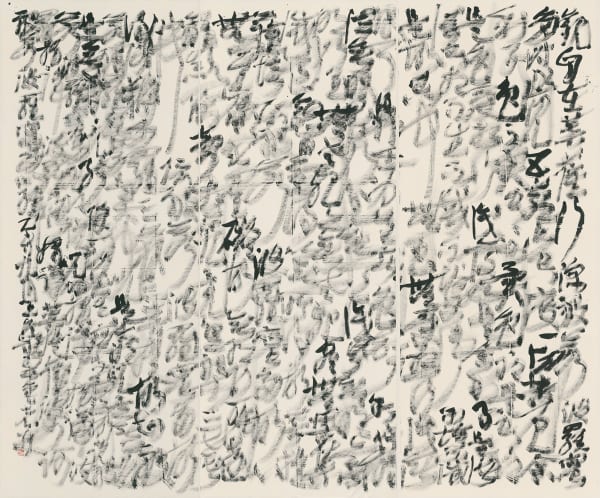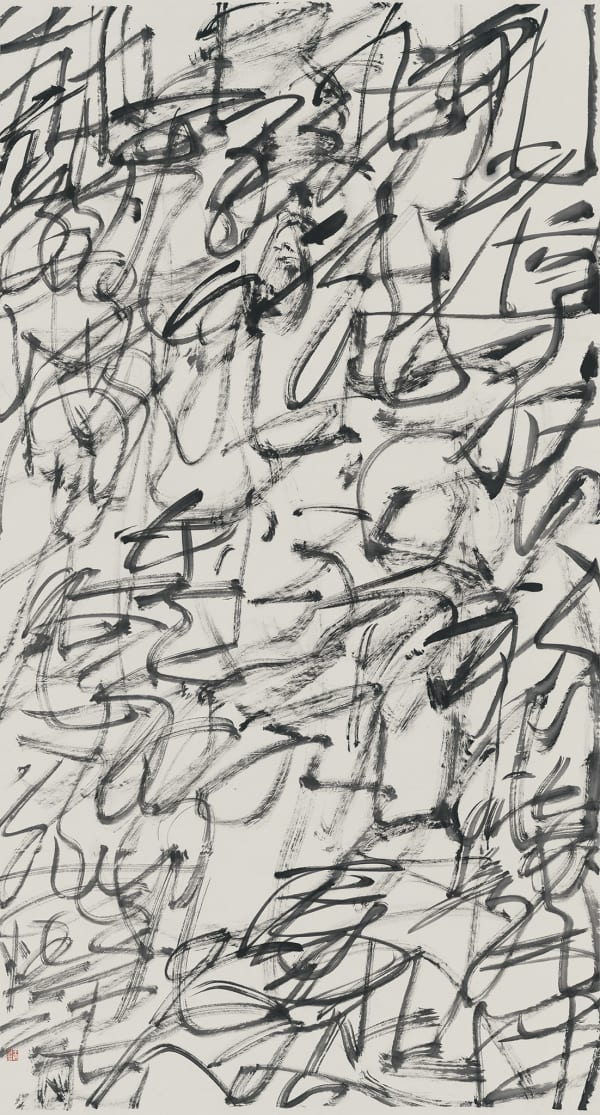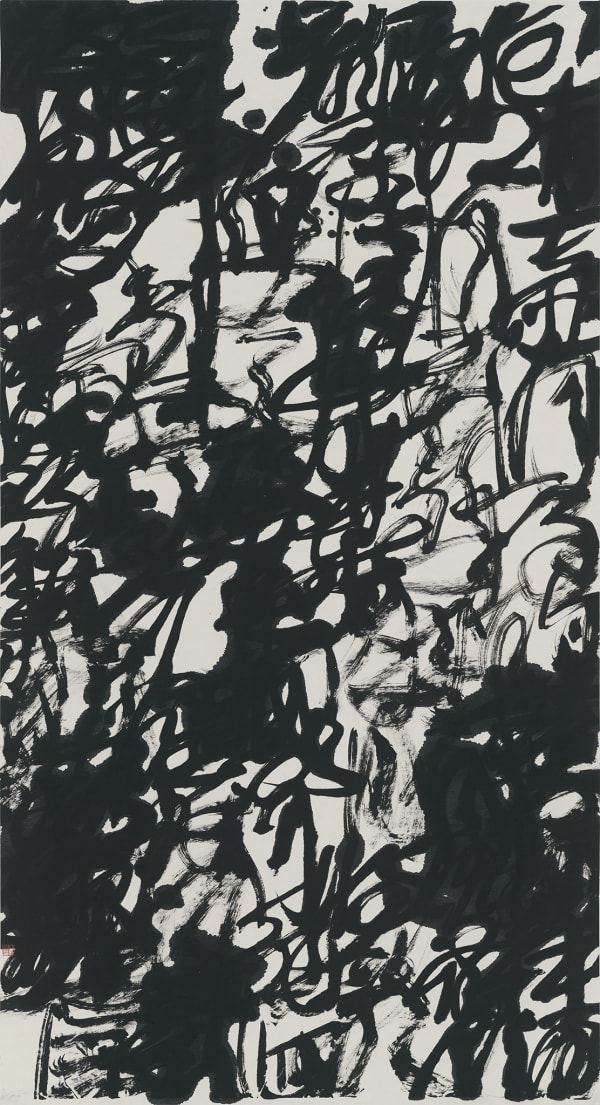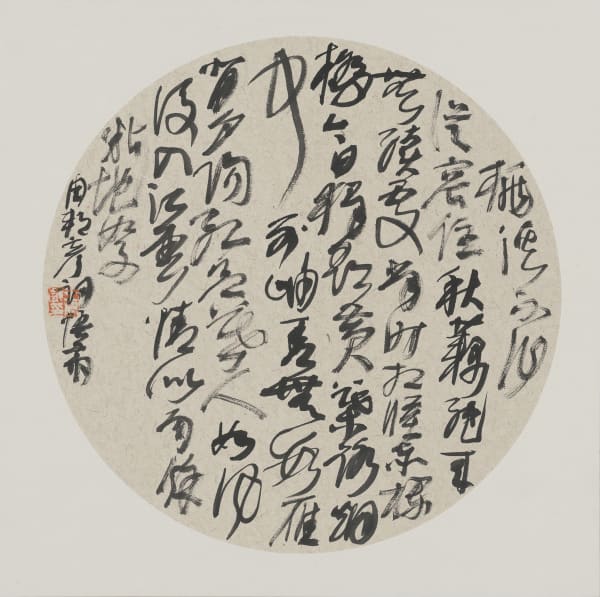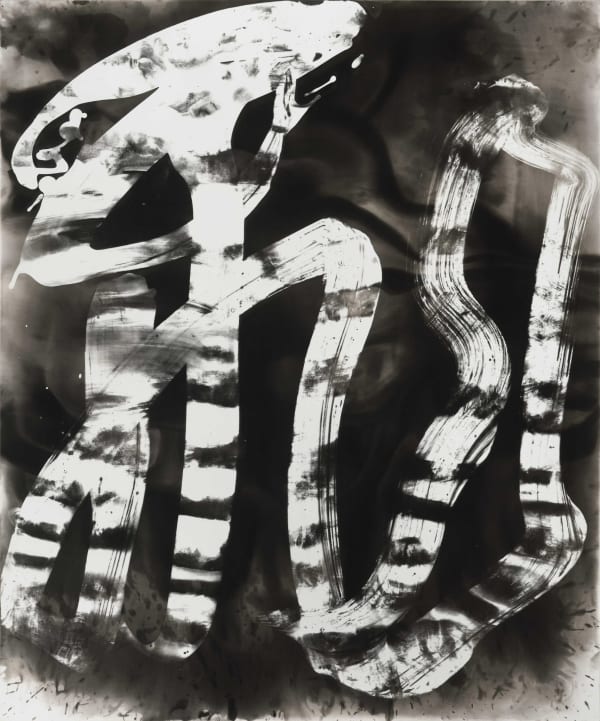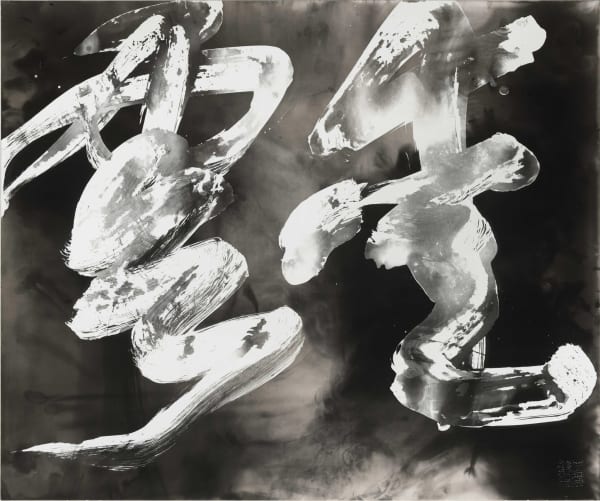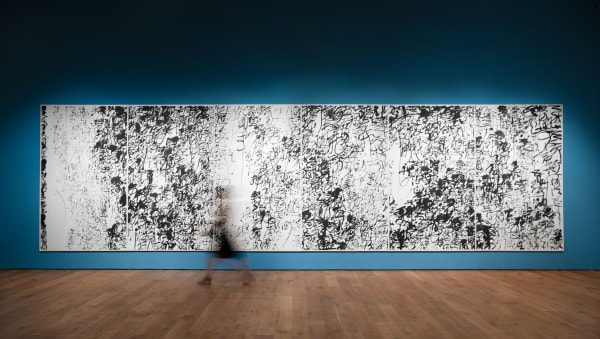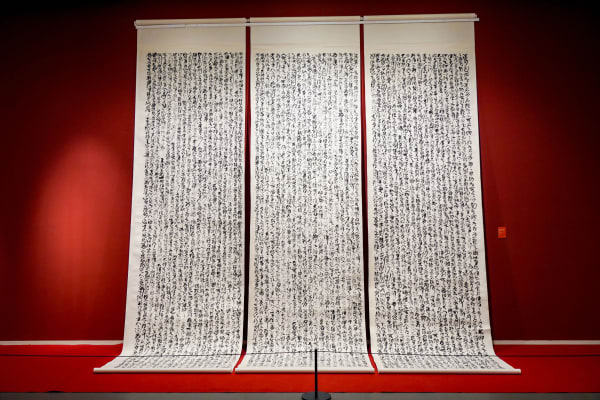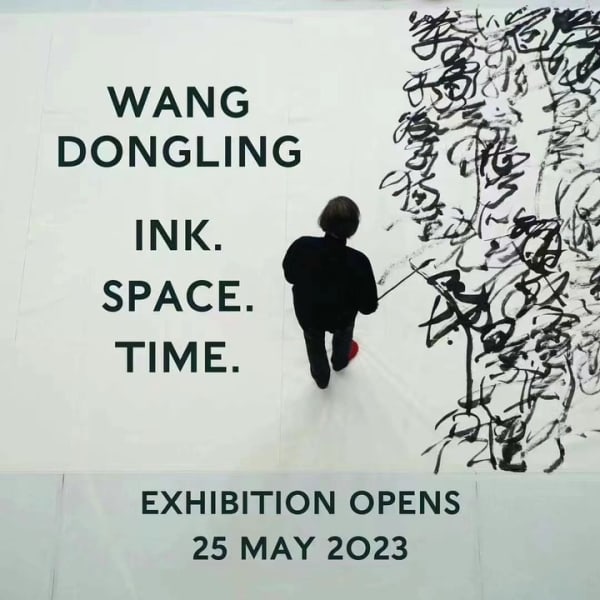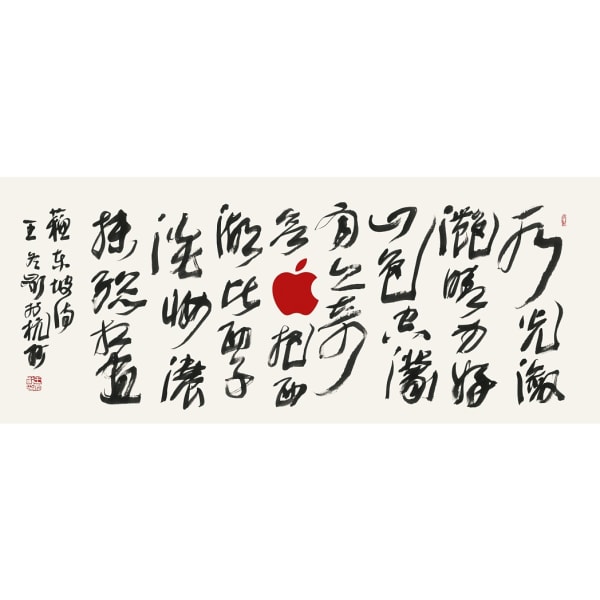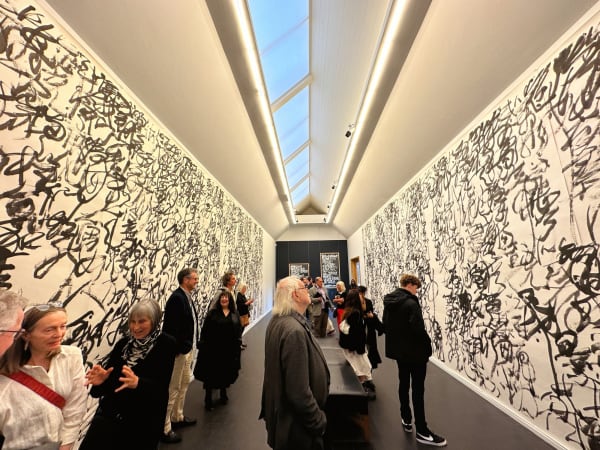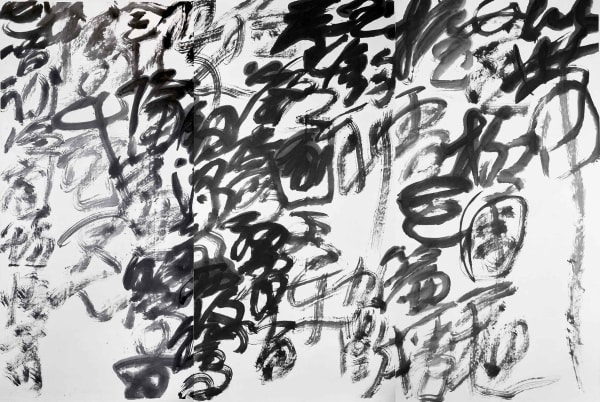b. 1945 in Rudong, Jiangsu province, lives and works in Hangzhou, Zhejiang province
Wang Dongling's artworks ground the modernist engagement with gestural abstraction and the post-modern skepticism of language and power in the pre-modern practice of embodied action and performance originally developed in Chinese calligraphy. Wang Dongling himself is widely recognized as China's greatest living calligrapher and is perhaps the only artist to have been granted three solo exhibitions at the National Art Museum of China. Although he is perhaps best known for public performances of monumental "mad" cursive script calligraphy, his artistic practice can be highly experimental and includes "enormous, swashbuckling abstractions" (Roberta Smith, New York Times, [December 12, 2013]) and calligraphy in new media, such as chemical photography, in which Wang's calligraphic actions are directly captured on silver-gelatin photographic paper.
Wang Dongling's innovations notably reinterpret for a new era two aspects of historical calligraphy practice-its creation through performance and its embrace of gestural abstraction. In his performances writing monument-scale calligraphy or abstraction, he lays bare to the public the connection between brush-and-ink and the body; he exposes the work of art as shaped directly by the artist's reach, stamina, and physical movement. In his calligraphic abstractions, Wang liberates calligraphic gesture, form and space from the bounds of text. The history of non-objective painting in twentieth-century Modernism and Minimalism is rife with references to calligraphy and its early embrace of gestural expression.
Wang Dongling is currently Director of the Modern Calligraphy Study Center at the China National Academy of Arts, Hangzhou. He graduated from the calligraphy department of the China National Academy of Art in 1981. His calligraphic work found rapid recognition in China where he exhibited in solo shows at the National Art Museum of China in Beijing (1987) and at the China National Academy of Art (1987). In 1989, Wang traveled to the United States where he taught the practice of calligraphy to Western art students and began his own exploration of pure abstraction. While in the United States, he exhibited in solo shows at the University of Illinois, the University of Kansas and the University of Minnesota (1989), again at the University of Minnesota and Montreal University (1990), and the University of California, Santa Cruz (1991). Wang was welcomed back to China for his second solo exhibition at the National Art Museum of China (1994) and throughout the 1990s participated in group exhibitions at the Hayward Gallery in London, which showed works that had been collected by the British Museum (1990), at the Yale University Art Gallery (1993), and at the National Art Museum of China in Beijing (1997). His work was featured in the New York exhibitionChinese Art & Civilization of Five Thousand Years at the Guggenheim Museum (1998), the Konsthall Gallery, Malmö, Sweden (1998), the British Museum (2002), the World Exposition, Nagoya, Japan (2003), the Metropolitan Museum of Art, New York (2006), The Louisiana Art Museum, Denmark (2007), the Art Academy of Rome (2007), and the Third Chengdu Biennale (2007). Wang had his third solo exhibition at the National Art Museum of China in 2007 and a solo exhibition at the Zhejiang Museum of Art in 2011.
Most recently, his works have been exhibited at the Hong Kong Museum of Art (2014), and at the Metropolitan Museum's Ink Art: Past as Present in Contemporary China show (2014). He is the subject of a documentary film, The Enduring Passion for Ink, and a forthcoming monograph, The Origins of Abstraction, edited by Dr. Britta Erickson.
Wang Dongling had his opening exhibition at Ink Studio in November 2013 where he showed his latest calligraphy-based, abstract ink paintings including One's Own Way (2013), his most ambitious abstraction in terms of scale to date, and his most recent experiments in "photographic calligraphy."
Wang Dongling's works can be found amongst others in the collections of the Metropolitan Museum, New York, the Guggenheim Museum, New York, the British Museum, London, the Palace Museum, Beijing, the National Art Museum of China, Beijing, the Zhejiang Museum of Fine Art, Hangzhou, the Yale University Art Gallery, Harvard University, and the University of California, Berkley.
-
 Jia Dao, “Beneath the Pine I Asked the Lad” 贾岛 松下问童子, 2019
Jia Dao, “Beneath the Pine I Asked the Lad” 贾岛 松下问童子, 2019 -
 Li Bai, “Bright Moonlight in Front of My Bed“ 李白 床前明月光, 2019
Li Bai, “Bright Moonlight in Front of My Bed“ 李白 床前明月光, 2019 -
 The Heart Sutra 心经, 2015
The Heart Sutra 心经, 2015 -
 Wandering Beyond 逍遥游, 2016
Wandering Beyond 逍遥游, 2016 -
 The Thousand Character Classic 千字文, 2014
The Thousand Character Classic 千字文, 2014 -
 The Qian Hexagram from the Book of Changes 易经·乾, 2016
The Qian Hexagram from the Book of Changes 易经·乾, 2016 -
 Li Bai, "Drinking Alone in Moonlight: Verse One" 李白 月下独酌四首·其一, 2016
Li Bai, "Drinking Alone in Moonlight: Verse One" 李白 月下独酌四首·其一, 2016 -
 Zhang Xu, "The Peach Blossom Stream" 张旭 桃花溪, 2016
Zhang Xu, "The Peach Blossom Stream" 张旭 桃花溪, 2016 -
 Huang Tingjian, "The Modest Garden Cannot Expect Clouds and Rain," to the Tune of Dingfengbo 黄庭坚 定风波·小院难图云雨期, 2016
Huang Tingjian, "The Modest Garden Cannot Expect Clouds and Rain," to the Tune of Dingfengbo 黄庭坚 定风波·小院难图云雨期, 2016 -
 Yan Jidao, "Finding the Terrace Locked after my Dream," to the Tune of Linjiangxian 晏几道 临江仙·梦后楼台高锁, 2016
Yan Jidao, "Finding the Terrace Locked after my Dream," to the Tune of Linjiangxian 晏几道 临江仙·梦后楼台高锁, 2016 -
 Zhou Bangyan, "Refusing to Live Leisurely by the Peach Blossom Stream," to the Tune of Yulouchun 周邦彦 玉楼春·桃溪不作从容住, 2016
Zhou Bangyan, "Refusing to Live Leisurely by the Peach Blossom Stream," to the Tune of Yulouchun 周邦彦 玉楼春·桃溪不作从容住, 2016 -
 Huang Tingjian, "The Modest Garden Cannot Expect Clouds and Rain," to the Tune of Dingfengbo 黄庭坚 定风波·小院难图云雨期, 2016
Huang Tingjian, "The Modest Garden Cannot Expect Clouds and Rain," to the Tune of Dingfengbo 黄庭坚 定风波·小院难图云雨期, 2016 -
 No Image 无影, 2013
No Image 无影, 2013 -
 More than White, Mist 非白.云, 2013
More than White, Mist 非白.云, 2013 -
 Flying 飞, 2013
Flying 飞, 2013 -
 Love Cloud 爱雲, 2013
Love Cloud 爱雲, 2013 -
 Primordial Line 一画, 2013
Primordial Line 一画, 2013 -
 Flowers' Dance 花飞, 2013
Flowers' Dance 花飞, 2013
-

Global INK: INKstudio’s Ten Year Anniversary Exhibition
Bingyi, Chen Haiyan, Huang Chih-yang, Li Jin, Li Huasheng, Liu Dan, Peng Kang-long, Wang Dongling, Wang Tiande, Xu Bing, Yang Jiechang, Zheng Chongbin 17 Jun - 29 Jul 2023The current exhibition, Global INK, is our opportunity to share with everyone what we have discovered over our first decade of programming. It is not a group show but instead a special exhibition consisting of twelve separate solo presentations by twelve artists who we believe define the new global contemporary INK.Read more -

Writing Chaos
Wang Dongling 17 Sep - 20 Nov 2016Writing Chaos unfolds the significance of Wang Dongling's Chaos Script—a new calligraphic script style that overturns the very foundations of the art.Read more -

INK AND THE BODY
Ink and Phenomenology, Exhibition No. 1 21 Sep - 15 Nov 2014Ink Studio’s premier group show, Ink and the Body , launches a planned series of three exhibitions examining ink painting in terms of the relationship between the subject and both...Read more -

THE ORIGINS OF ABSTRACTION
WANG DONGLING 9 Nov 2013 - 5 Jan 2014// Installation Video Works can fall short of one's ideals, but a successful work must embody my true feelings because this work is not created by my hand but by...Read more
-

Exhibition | Wang Dongling's solo exhibition "Pilgrim to Tianjin" at Tianjin Art Museum
November 1, 2024Pilgrim to Tianjin: Wang Dongling's Calligraphy Works 2024.10.26 - 2025.1.5 Tianjin Art Museum, Tianjin This exhibition presents over 100 representative works, encapsulating Wang Dongling’s unwavering...Read more -

Time Gravity - 2023 Chengdu Biennale|He Yunchang, Li Huasheng, Wang Dongling, Wang Tiande, Xu Bing, Yang Jiechang, Zheng Chongbin
August 12, 2023Time Gravity - 2023 Chengdu Biennale Date: July 16–November, 2023 Venue: Area A and B of Chengdu Art Museum in Tianfu Art Park, Chengdu (Chengdu...Read more -

Exhibition | Wang Dongling at The Heong Gallery
May 31, 2023Wang Dongling: Ink. Space. Time. Date: 5.25-8.27, 2023 Venue: The Heong Gallery, Downing College, Cambridge CB2 1DQ Curated by Holly Roussell For his new, site-specific...Read more -

INKstudio at West Bund 2021
Jeong Gwang Hee, Lee In, Li Huasheng, Wang Dongling, Wang Tiande November 6, 2021BOOTH A212 11-14. 11, 2021 West Bund Art Center, Building A INKstudio will explore INK as the basis for an international contemporary art rooted in...Read more -

Exhibition | From Inception: Wang Dongling 60 Years of Calligraphy
October 29, 2021FROM INCEPTION: Wang Dongling 60 Years of Calligraphy 2021.10.16 - 2021.11.14 Zhejiang Art Museum This exhibition focuses on China Academy of Art's professor, Wang Dongling's...Read more -

Artist Panel: “Four Takes on the 1980’s”
November 4, 2016Moderators: Craig Yee (INK studio Director), Alan Yeung (INK studio Chief Editor) Participating artists: Li Jin, Wang Dongling, Zheng Chongbin, Zhang Jianjun In the late...Read more -

ART FAIR | INK STUDIO IN SHANGHAI, NOVEMBER 2016
November 3, 2016INK studio is excited to announce its programs in Shanghai in November 2016, at West Bund Art & Design, Art021 Shanghai Contemporary Art Fair, and Shanghai Biennale and featuring the new work of internationally celebrated artists Li Jin, Jennifer Wen Ma, Wang Dongling, and Zheng Chongbin.Read more -

EXHIBITION | Wang Dongling at the Imperial Ancestral Temple, Beijing
October 29, 2016Wang Dongling’s landmark solo exhibition Between Heaven and Heart: Wang Dongling’s Calligraphy will be on view at the Imperial Ancestral Temple in Beijing from November...Read more -

Exhibition | Wang Dongling at the University of Auckland
July 5, 2016Gus Fisher Gallery at the University of Auckland will host a solo exhibition of Wang Dongling's work, encompassing his traditional calligraphy, chaos script calligraphy, calligraphy...Read more -

Performance | Wang Dongling at the Brooklyn Museum
October 29, 2015On November 7, 2015, Wang Dongling will give a public performance at the Brooklyn Museum. He will write the Heart Sutra in his groundbreaking invention...Read more -

EXHIBITION | Writing Non-Writing: Wang Dongling
June 17, 2015On May 8, 2015, Wang Dongling's solo exhibition 'Writing Non-Writing' opened at the Sanshang Contemporary Art Museum in Hangzhou, featuring works from his Squiggles series,...Read more -

EXHIBITION | WANG DONGLING IN CHINA 8 - CONTEMPORARY CHINESE ART ALONG THE RHINE AND RUHR
April 30, 2015Wang Dongling will participate in CHINA 8, 'the most comprehensive survey of contemporary Chinese art held in Germany to date.' Taking place across 9 museums...Read more -

EVENT | Wang Dongling: Calligraphic Artwork to commemorate the opening of Asia's largest Apple Store in Hangzhou, China (Video)
January 24, 2015To celebrate the opening of the new and largest-in-Asia Apple Store West Lake in Hangzhou, China, calligrapher-artist Wang Dongling has created a mural that covers...Read more
-

2023 Gallery Weekend Beijing | Global INK: INKstudio’s Ten Year Anniversary Exhibition
June 30, 2023Read more -

The Enduring Passion for Ink: A Project on Contemporary Ink Painters
Britta Erickson February 7, 2017The Enduring Passion for Ink: A Project on Contemporary Ink Painters (or the 'Project') is a proposed exhibition, book, and film series designed to introduce...Read more -
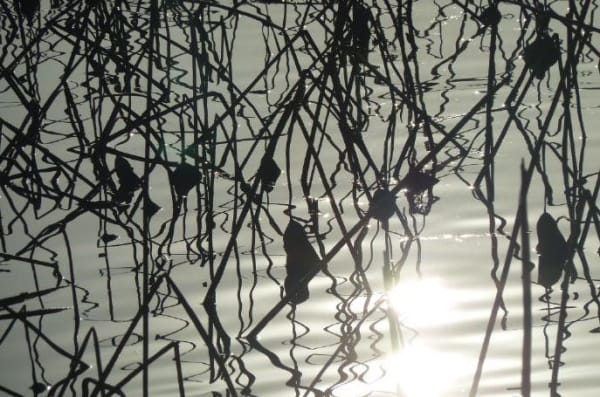
Amidst the Enchanting, Riotous Blossoms
December 14, 2016Read more -
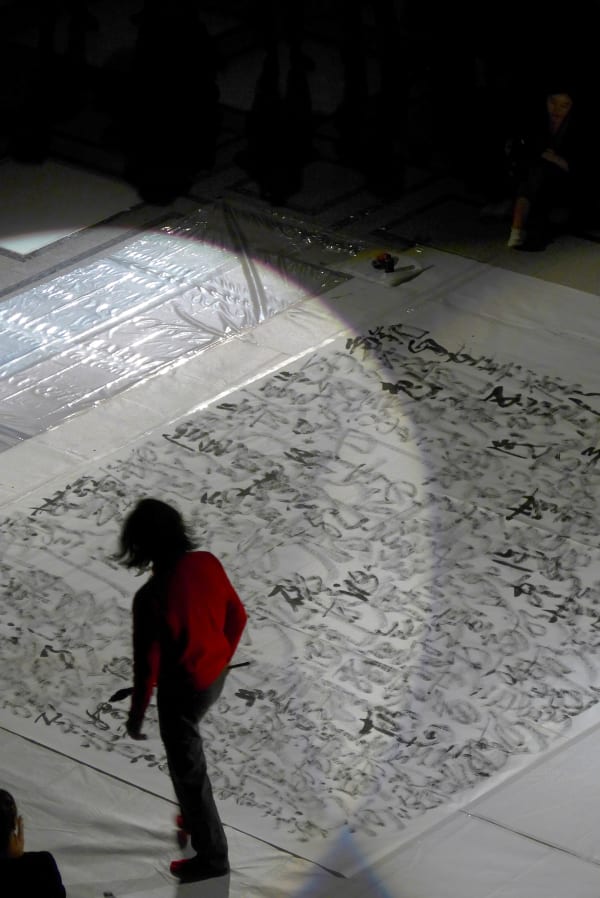
Wang Dongling: the Heart Sutra in Chaos Script at Brooklyn Museum
September 18, 2016Read more -
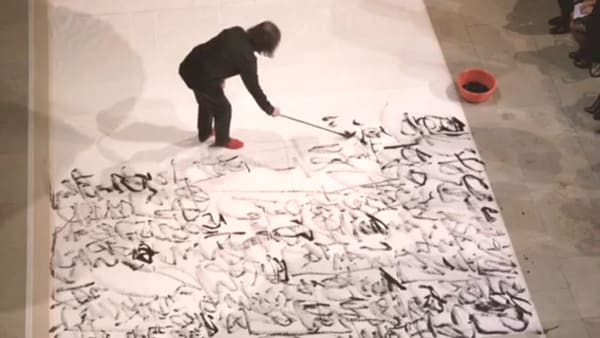
Wang Dongling, Heart Sutra in Chaos Script at Auckland Art Gallery, New Zealand
July 22, 2016Read more
-

Transcendental Lines : Order and Chaos in Wang Dongling’s Universe
Holly Roussell -

Chaos Script: The Dialectic Between Order and Chaos
Gao Shiming -

Wang Dongling and the Pearl of Creation
Britta Erickson -

Wang Dongling: Chaos in New York
Ink Studio -

Huang Binhong and Wang Dongling's Squiggles Series
Ted Chen -

Ink and the Body: A Phenomenological Approach
Amjad Majid

